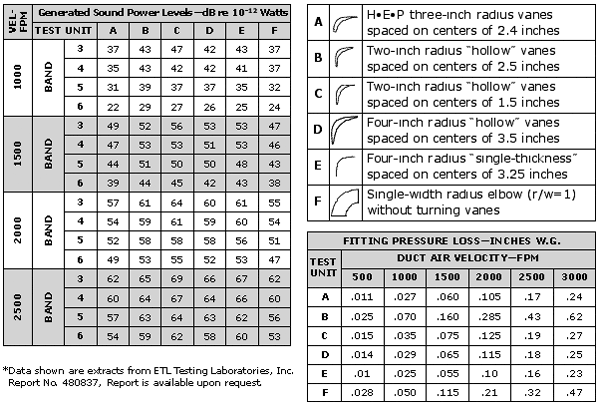Aero Dyne H-E-P Turning Vanes are laboratory tested and certified for performance.
The High Efficiency Profile design lowers pressure loss and generates sound power through 17 points of roll forming precision. No other Turning Vane provides comparable quality, structural integrity & performance.
Based on results from the ETL Testing Laboratories, Inc. Report no. 48037, Aero Dyne H-E-P Turning Vanes had lower sound power levels when compared to four other turning vane designs. Lower sound power levels will result in lower sound pressure levels (dB). Based on the same report, the H-E-P Turning Vane performed better or equal to a single-width radius elbow in 8 of the 16 tests.
Aero Dyne Turning Vanes resulted in much lower pressure loss (in WC) when compared to a single-width radius elbow. The H-E-P turning vane also resulted in lower pressure loss when compared to the other three double wall turning vane designs in the report.
Beware, depending on the fabrication method and steel gauge used to make other turning vanes, performance will vary. Turning vane performance may not be consistent with these test results.
Aero Dyne Turning Vanes & Rail are manufactured the same today as they were 50 years ago, so quality will never vary. H-E-P Turning Vanes are engineered for performance. To avoid a costly replacement job, always require independent performance test data when specifying turning vanes and rail for your project.
LEED Contribution
Aero Dyne Turning Vanes & Rail help contribute to the USGBC LEED rating system.
LEED for Healthcare – Meet the minimum-maximum Design Criteria for Noise in representative interior rooms and spaces. NC, RC(N), RNC , or dBA are the different methods that can be used to rate or measure the sound to determine acceptability. The minimum and maximum room noise values are established in the Sound and Vibration Design Guidelines for Healthcare Facilities (2010 SV Guidelines) and outlined in the 2010 FGI Guidelines for Design and Construction of Healthcare Facilities (2010 FGI Guidelines).
LEED for Schools – Achieve a maximum background noise level from heating, ventilating , and air conditioning (HVAC) systems in classrooms and other core learning spaces of 45 dBA (40 dBA if attempting IEQ Credit 9). Recommended methodologies and best practices for mechanical system noise control are described in Annex B of ANSI Standard S12.60-2002 and the 2007 HVAC Applications ASHRAE Handbook, Chapter 47 on Sound and Vibration Control.
How H-E-P Turning Vanes can help improve acoustical performance and room noise compliance
Laboratory test data (Report no. 48037 dated 9/5/87) proves H-E-P Turning Vanes and Rail have reduced sound power levels as compared to symmetrical vanes, single thickness vanes, and vanes with different center spacing. Lower sound power levels will result in lower sound pressure levels (dBA) for comparable installations.
Having lower sound pressure levels can help achieve the following LEED credits:
- LEED for Schools v9 IEQ Pre-Requisite 3 – Minimum Acoustical Performance
- LEED for Schools v9 IEQ Credit 9 – Enhanced Acoustical Performance
- LEED for Healthcare IEQ Credit 2 – Acoustical Environment

